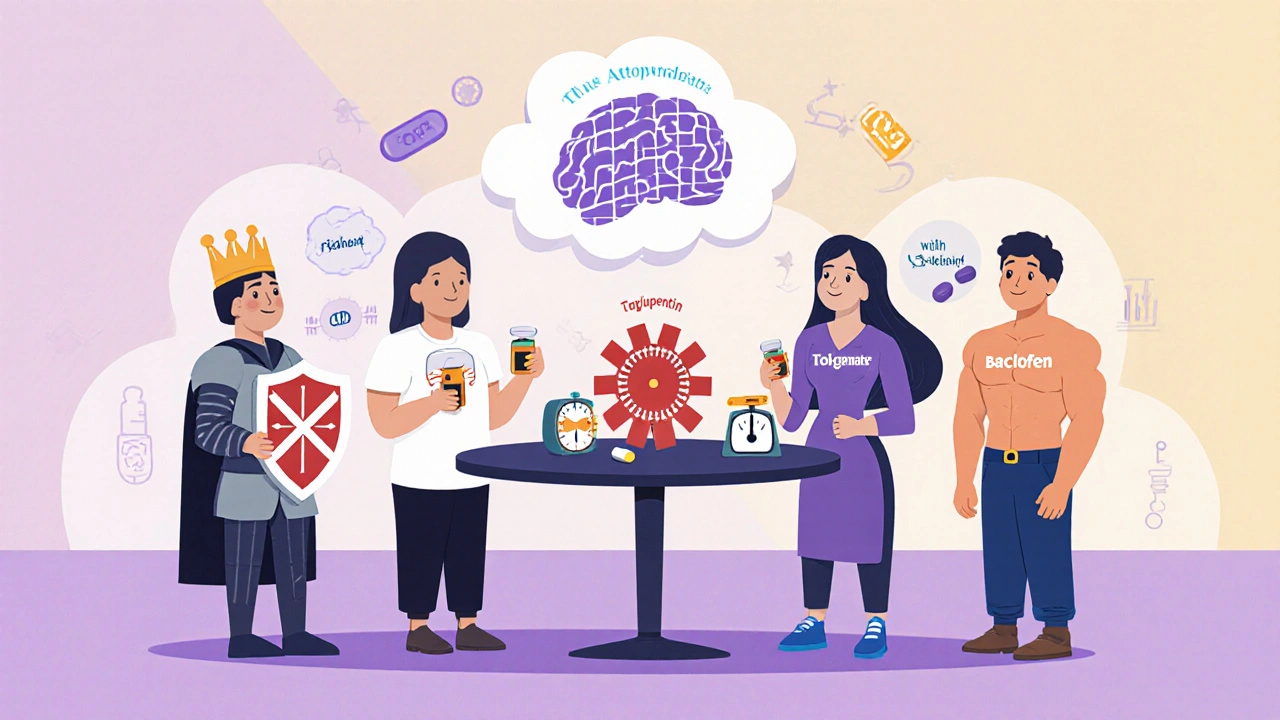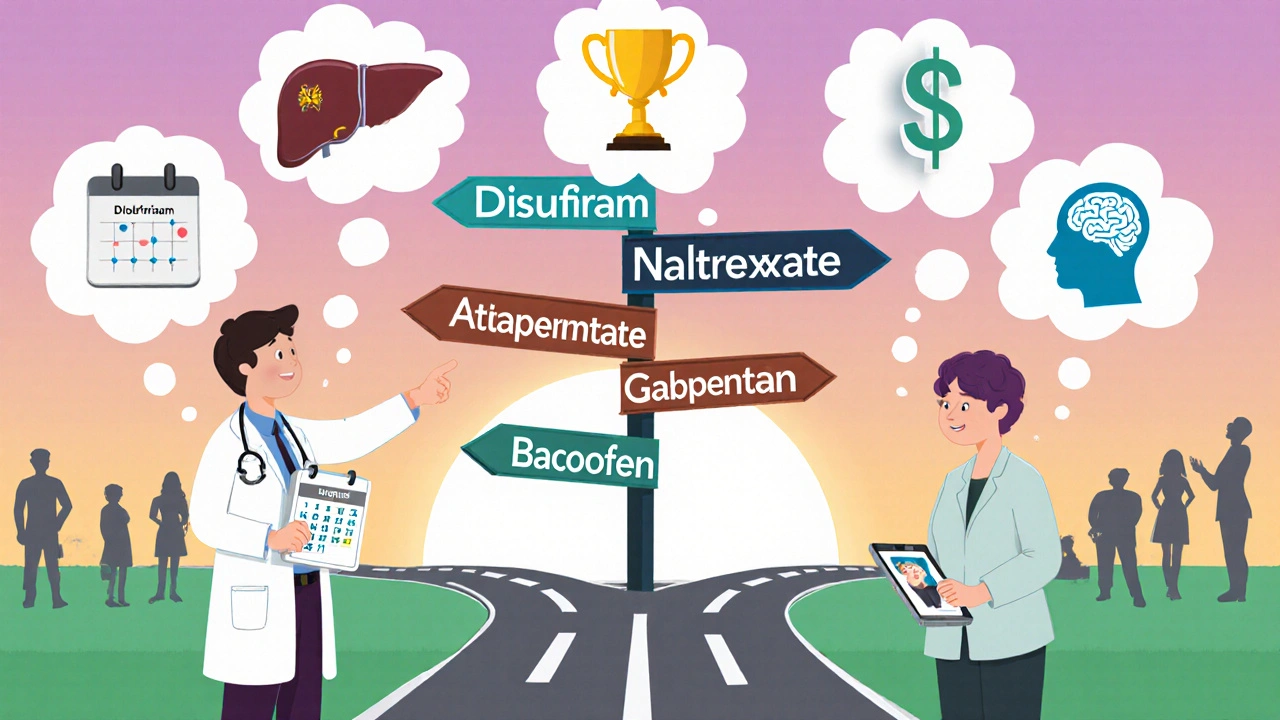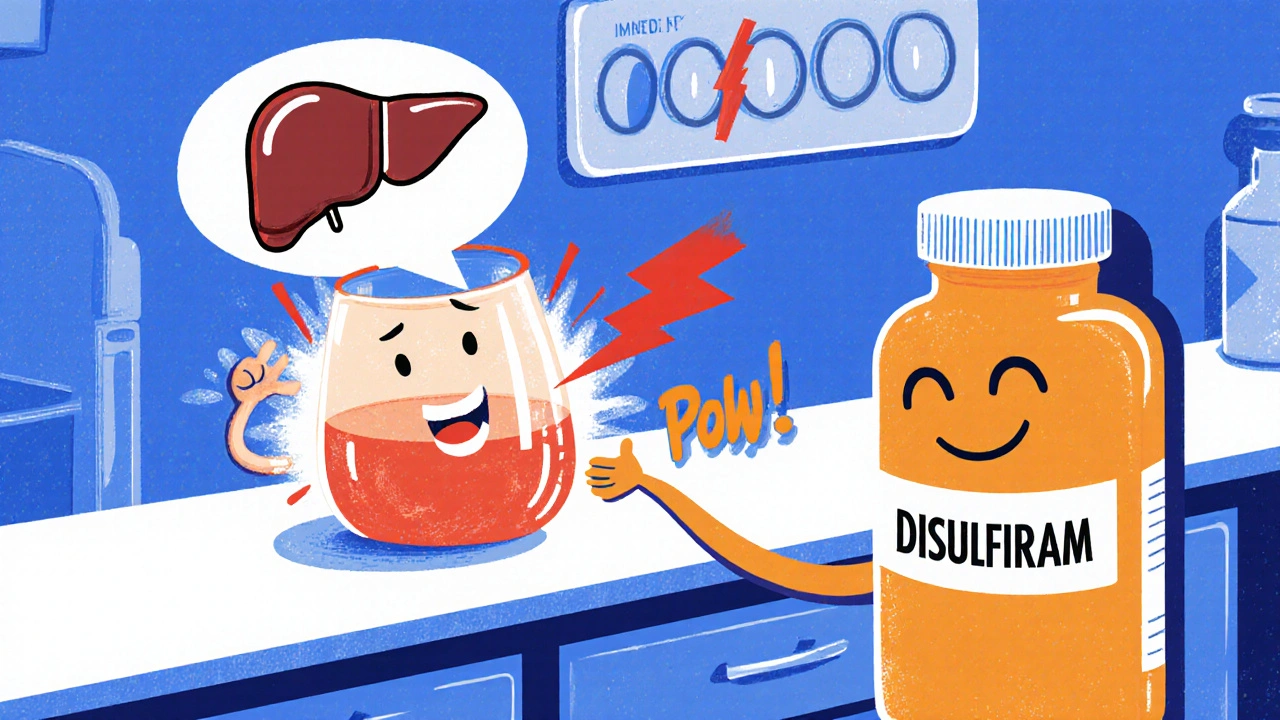Alcohol Use Disorder Medication Selector
Find the Best Medication for You
This tool helps identify the most appropriate medication for alcohol use disorder based on your health profile and preferences.
When it comes to treating alcohol use disorder, many people think of Disulfiram as the go‑to option. But is it really the best fit for every patient? This guide breaks down Disulfiram, compares it with the most common alternatives, and helps you decide which medication lines up with your goals, health profile, and lifestyle.
Key Takeaways
- Disulfiram creates an aversive reaction to alcohol, making drinking uncomfortable.
- Alternatives such as Naltrexone, Acamprosate, Topiramate, Gabapentin, and Baclofen work through different brain pathways and have distinct side‑effect profiles.
- Choosing the right drug depends on factors like liver health, compliance ability, co‑occurring conditions, and cost.
- Combination therapy can be effective for some, but requires careful medical supervision.
- Regular monitoring and counseling remain essential, regardless of the medication chosen.
What is Disulfiram (Antabuse)?
Disulfiram is an oral medication that interferes with the metabolism of ethanol. It blocks the enzyme aldehyde dehydrogenase, causing acetaldehyde to build up when alcohol is consumed. The result is a flushing, pounding headache, nausea, and rapid heartbeat that can last for up to an hour. This "deterrent" effect is why clinicians often prescribe it to highly motivated patients who can commit to strict abstinence. The drug itself is taken once daily, usually 250mg, and does not require blood‑level monitoring.
How Disulfiram Works - The Science in Plain Language
The brain’s reward system releases dopamine when you drink. Disulfiram doesn’t touch those dopamine pathways; instead, it hijacks the body’s chemical processing of alcohol. By turning ethanol into a toxic by‑product, the medication makes drinking an unpleasant experience. This mechanism is simple, but it also means the drug only works if the patient truly avoids alcohol.
Who Benefits Most from Disulfiram?
- Patients who have a strong desire to stay sober and can reliably remember daily dosing.
- Individuals with good liver function (the drug is processed by the liver).
- Those who prefer a low‑cost, once‑daily regimen with minimal lab work.
Conversely, anyone with severe liver disease, a history of severe reactions to alcohol, or poor medication adherence may struggle with Disulfiram.

Common Alternatives - A Quick Overview
Below are the five most frequently considered alternatives. Each targets a different neurochemical pathway, offering options for patients who can’t use Disulfiram or need a complementary approach.
Naltrexone is an opioid receptor antagonist that reduces the rewarding effects of alcohol. It’s taken once daily (50mg) or as a monthly injection (380mg).
Acamprosate works on the glutamate system to stabilize brain chemistry after detox. Typical dosing is 666mg three times daily.
Topiramate is an anticonvulsant that also dampens dopamine release. Doses start at 25mg nightly and may increase to 200mg per day.
Gabapentin modulates GABA activity and can reduce cravings and withdrawal symptoms. Typical dose ranges from 300mg three times daily to 1,800mg per day.
Baclofen is a GABA‑B agonist that reduces the urge to drink, especially in patients with co‑occurring anxiety. Doses start at 5mg three times daily, titrating up to 30mg three times daily.
Side‑Effect Snapshot
| Medication | Common Side‑Effects | Serious Risks |
|---|---|---|
| Disulfiram | Headache, flushing, nausea when alcohol is consumed | Liver toxicity (rare), severe reaction if alcohol is ingested |
| Naltrexone | Insomnia, dizziness, nausea | Liver enzyme elevation, potential for hepatotoxicity |
| Acamprosate | Diarrhea, abdominal pain | Kidney impairment in severe cases |
| Topiramate | Paresthesia, cognitive “fog”, weight loss | Metabolic acidosis, kidney stones |
| Gabapentin | Somnolence, dizziness, peripheral edema | Potential misuse, respiratory depression in high doses |
| Baclofen | Weakness, drowsiness, dry mouth | Seizures if abruptly stopped, hypotension |
Effectiveness - What the Data Say
Large‑scale meta‑analyses show that Disulfiram reduces heavy drinking days by roughly 20% compared with placebo, but only when adherence exceeds 80%. Naltrexone drops the risk of relapse by about 30% and works even if the patient slips and drinks occasionally. Acamprosate’s impact on total abstinence is modest (around 10% improvement) but helps maintain sobriety after detox.
Topiramate and Gabapentin are off‑label for AUD, yet several randomized trials report 25‑30% reductions in craving scores. Baclofen shines in patients with co‑occurring liver disease because it bypasses hepatic metabolism.
Choosing the Right Medication - A Decision Framework
- Assess liver function. If liver enzymes are elevated, avoid Disulfiram and Naltrexone; consider Acamprosate, Baclofen, or Gabapentin.
- Measure motivation and adherence ability. Highly motivated patients who can remember daily pills are good candidates for Disulfiram. Those with adherence concerns may benefit from the monthly injectable form of Naltrexone.
- Identify co‑occurring conditions. Anxiety or chronic pain often points to Gabapentin or Baclofen. Seizure history leans toward Topiramate (which also treats seizures).
- Consider cost and insurance coverage. Disulfiram and Acamprosate are generally inexpensive generic options. Injectable Naltrexone can be pricey without insurance.
- Plan for side‑effect management. If weight loss is a concern, avoid Topiramate. If cognitive fog is unacceptable, steer clear of Topiramate and high‑dose Gabapentin.
In many cases, clinicians combine two agents-like Naltrexone plus Acamprosate-to cover both craving reduction and withdrawal stabilization. Such combos should be started under specialist supervision.

Practical Tips for Patients
- Keep a medication calendar or use a phone reminder to avoid missed doses.
- Never drink alcohol while on Disulfiram; even a sip can trigger severe reactions.
- Schedule regular liver function tests if you’re on Naltrexone or Disulfiram.
- Stay in touch with a counselor or support group; medication works best when paired with behavioral therapy.
- Discuss any over‑the‑counter or herbal supplements with your doctor-some can interfere with metabolism.
Cost Snapshot (2025 US Prices)
- Disulfiram (generic): $0.15‑$0.30 per tablet.
- Naltrexone (oral generic): $0.60‑$1.00 per tablet; injectable Vivitrol: $1,200‑$1,500 per dose.
- Acamprosate (generic): $0.70‑$1.20 per tablet.
- Topiramate (generic): $0.25‑$0.50 per tablet.
- Gabapentin (generic): $0.20‑$0.40 per tablet.
- Baclofen (generic): $0.15‑$0.35 per tablet.
Prices vary by pharmacy and insurance plan. Ask your provider about patient‑assistance programs for high‑cost options like injectable Naltrexone.
When to Switch or Add a Medication
If you’ve been on Disulfiram for three months and still experience cravings or occasional slips, talk to your doctor about adding a craving‑reducer like Naltrexone. Conversely, if you develop liver irritation, a switch to Acamprosate, Baclofen, or a low‑dose Gabapentin may be safer.
Frequently Asked Questions
Can I take Disulfiram and Naltrexone together?
Combining the two is generally not advised because both affect liver enzymes. If a clinician feels a combo is necessary, they will monitor liver function closely and adjust doses.
What happens if I accidentally drink alcohol while on Disulfiram?
You’ll experience flushing, rapid heart rate, nausea, and vomiting within 10‑30 minutes. In rare cases, this can lead to severe cardiovascular stress, so immediate medical attention is recommended.
Is Acamprosate safe for people with kidney disease?
Acamprosate is cleared by the kidneys, so dosage reduction is needed for patients with moderate to severe renal impairment. Your doctor may prefer Baclofen or Gabapentin in such cases.
Do any of these medications cause weight loss?
Topiramate often leads to weight loss, which can be a benefit for some but unwanted for others. Naltrexone and Acamprosate have neutral effects on weight.
Can I stop Baclofen abruptly?
No. Stopping Baclofen suddenly can trigger seizures or severe withdrawal symptoms. Taper the dose gradually under medical supervision.


Comments
Disulfirum seems fine, but i’m not sure.
Thank you for presenting such a thorough overview. I appreciate the balanced tone and the inclusion of both clinical data and practical tips. Patients often feel overwhelmed by the myriad of options, so a clear comparison is invaluable. Your emphasis on liver function and adherence is especially noteworthy, as these factors frequently dictate treatment success.
The pharmacodynamics delineated herein render most alternatives subordinate.
Look, America needs tough meds that actually keep people from drinking, not half‑hearted pills that let them slip. Disulfiram is a straight‑up deterrent, and if you’re not willing to take a drug that makes alcohol taste like poison, you’re not serious about sobriety. This isn’t a time for coddling; it’s a battle, and we need weapons, not therapy sessions.
I love how you highlighted the practical tips, like using a medication calendar. Collaboration between prescriber and patient is key, especially when side‑effects differ so much. It’s great to see the mention of counseling alongside meds – that’s where real change happens.
Ah, the grand tapestry of pharmacology, woven with threads of hope and despair!; Disulfiram stands as the stern sentinel, daring the intrepid soul to confront the abyss of desire. Yet, let us not forget the subtle alchemy of Naltrexone, which gently untangles the opioid‑laden reward circuitry, whispering promises of moderation.
Acamprosate, the quiet guardian, seeks equilibrium in the glutamatergic storm, coaxing the brain back to a tranquil shore. Topiramate, with its fog‑laden mind‑cloud, offers a paradox – clarity through obscurity, weight loss as a side‑effect of liberation.
Gabapentin saunters in, a GABAic diplomat, easing withdrawal yet flirting with misuse, a double‑edged sword indeed. Baclofen, the muscular relaxant, steps forth for those haunted by hepatic shadows, bypassing the liver’s unforgiving gaze.
Each molecule, a philosophy, each dosage, a stanza in the epic of recovery; together they compose a symphony where adherence is the conductor.
When compliance wanes, the music falters – a reminder that even the most potent compound cannot substitute for resolve.
Side‑effects, those mischievous sprites, dance around the periphery: headaches, nausea, cognitive fog – all while the patient strives for clarity.
The economics of treatment cannot be ignored; a cheap tablet may outlast a pricey injection, yet insurance tides can sway decisions like a fickle wind.
Combination therapy, a daring duet, may amplify benefits, but only under vigilant stewardship, lest discord arise.
In the end, the choice rests upon a triad: liver health, motivation, and comorbidities – a triad as ancient as the Hippocratic oath.
Thus, dear reader, wield these insights like a seasoned artisan, shaping each regimen to fit the unique vessel of the patient. :)
I totally get how overwhelming it can feel – the sheer number of options is like a maze. Your breakdown makes it much easier to see which path might fit someone’s lifestyle and health status.
Dude, that was a wild ride through the med world. I love the vibe of “choose your own adventure” but with real science backing it up.
When picking a drug, start with liver labs, then match the patient’s motivation level. If adherence is shaky, lean toward injectable Naltrexone.
Wow, this guide paints a vivid picture – like a colorful mural of meds, each with its own flair and cautionary whisper.
While the article is comprehensive, it neglects to address the nuanced ethical considerations of prescribing aversive agents without fully informed consent, which remains a critical oversight.
Indeed, the moral dimension is as vital as the pharmacological one; a patient’s autonomy must never be eclipsed by a clinician’s desire for rapid results.
From a mechanistic perspective, the interplay between dopaminergic reward attenuation (Naltrexone) and glutamatergic homeostasis (Acamprosate) offers a synergistic substrate for relapse mitigation, especially when titrated within therapeutic windows to avoid hepatotoxic threshold breaches.
That’s a solid point – balancing efficacy with safety is the real art of prescribing.
Thanks for breaking it down in such a clear way. It helps a lot to understand which option might work best for different people.